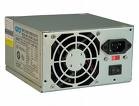Why Your Power Supply Choice Is So Important
 Your computer’s power supply, or PSU, is a critical part of your computer. It has to supply the exact or near exact voltage at the required wattage to all of the circuitry inside your computer. The processor and memory are particularly sensitive and require an exact supply or as near as possible to one.
Your computer’s power supply, or PSU, is a critical part of your computer. It has to supply the exact or near exact voltage at the required wattage to all of the circuitry inside your computer. The processor and memory are particularly sensitive and require an exact supply or as near as possible to one.
So, why does your choice of power supply matter so much when building your rig?
Despite the sensitive voltage and current regulator circuitry on most motherboards; generally adjacent to the processor (CPU) or memory (RAM) itself, the supply of power to the motherboard with respect to these components needs to be as near spot-on as possible. If your power supply unit (PSU) has trouble delivering that then strange things start to happen.
Your computer may start acting strangely or even produce repeated stop errors or blue screens of death. (BSOD) The event logs may record these as being due to memory errors, and probably correctly so, but the memory errors could be being caused by an insubstantial power supply to the RAM and/or CPU.
Why would this occur? There are a number of reasons that this may happen. The most obvious being that the PSU is wearing out and needs replacing.
Power supplies, like most other computer components, don’t last forever. How long they actually do last can depend upon the quality of the unit as well as the demands being made of it. A cheap and nasty supply may not be capable of delivering its stated wattage. If you’re loading it heavily by running a lot of hardware, it may actually produce a significant voltage drop across its output due to the high load. In fact, Computer Shopper magazine tested a number of different makes and models of power supplies for reliability during 2007 ( – And tested PSUs again during 2008.). One of the tests was to run the PSU under test at full load to see if it could deliver the wattage stated on the tin. Not many of the thirty or so PSUs under test could actually do so, although over half came near to the mark, supplying only a few tens of watts less than claimed. The cheapest PSUs were undoubtedly the worst in this test; with the cheapest PSU actually failing totally with a 500 Watt load, and another of the cheapest models literally blowing up in a self-detonation!
Straining a power supply results in heat building up within its components, as does the act of simply running it. I’ll rephrase that: Heat builds up within a power supply when it is being used, and straining a supply causes excessive heat to build up in its components. Heat is an electronic component’s enemy. It causes chemical changes within the component’s chemical structure which causes the individual components to become less effective. Overloading a supply will wear it out much quicker. Bearing in mind that many PSUs are unable to actually supply their stated Wattage, your PSU may be overloaded without you actually realizing it, especially if you’ve added new hardware such as an SLI graphics-card or similar.
Even if the above is not the case, power supplies don’t last forever. If you’re experiencing random frequent crashes it could be that the power supply requires replacement. (It could also be due to a phenomenon known as “capacitor plague“.)
Power supplies aren’t immune to power surges from the electricity grid, either. A large voltage spike, or even a brownout, where the mains voltage drops and fluctuates wildly, can in rare cases damage them – as well as, more likely, your other hardware. That’s why it’s always a sensible idea to run your mains power through at least a surge-protector, or better still a UPS, before connecting it to your system.
Finally, if you’re building your own computer or replacing the PSU in your existing box, then my advice to you is to calculate the combined wattage used by all your hardware, and buy a power-supply unit that’s rated around 100 watts greater than that figure. That way, providing you don’t buy the cheapest PSU available, you should have a certain amount of wattage to spare if your computer’s components require extra power at any point.





















5 thoughts on “Why Your Power Supply Choice Is So Important”
Measuring the exact amount of power consumed will involve connecting a watt meter in series with every component while it’s running at full-power, noting down the reading, and adding up all the readings at the end of the procedure. – Rather time consuming.
Estimating a rough figure, on the other hand, is easier. Google for the maximum amount of power used by each individual component, add the figures up, multiply by 1.25, and get yourself a decent quality power supply that is rated at least 100 watts or more above that figure. – That should do the trick.
I understand if you don’t want to post up something like as too many people take it verbatem and it can potentially come back to bite you.
1000 watts, however, will be extremely useful if you’re planning to move to quad-SLI graphics or similar in the future. (Assuming you’re not planning to install them initially.)
If your system uses 500 watts but you install a 1000 watt PSU then the difference is 500 watts: This is what you’ll have spare.
What happens to this spare capacity? If your system draws 500 watts then at that point the PSU, despite being rated at 1000 watts, only actually supplies 500 watts – without a problem.
Will installing this PSU mean I draw extra power from the electricity grid and waste it?
No. Your PSU is capable of doing so but it won’t unbless you load it fully by adding a fair bit of extra hardware.
Since you have all that spare wattage available I suggest that you use it to power SLI graphics, RAID disks, extra fans, lights, gadgets and gizmos. There’s an article on my blog about some freaky gadgets that you might like to consider installing.
If you use a over-rated PSU, you *will* use more electricity. PSUs are typically most efficient at around 30-40% of their load capacity, which is what they will be idling at most of the time (if you knew what you were doing and bought the right wattage PSU).
If you had a high efficiency PSU (85%+ efficiency), but bought one twice as powerful as needed, you could be experiencing a very low efficiency of 70% or so, well off the peak of the efficiency bell curve – a big waste of electricity on a computer that may be on 24/7.
I find it curious that in every post I make; whether on my blog or on any other, you eventually turn up and try to rubbish everything I say. That behaviour is otherwise known as stalking and obsessive compulsive disorder. (OCD)
The best thing to do is to avoid the garbage PSU’s and to buy a PSU that’s rated well over the maximum power requirement for your computer….like at least 20%-25% more. The closer you get to your PSU’s maximum output, the more likely you are to get bad voltages, the shorter its lifespan and the more likely it is to fail and damage components.
In any power supply worth buying, thermal compensation exists within the circuitry in the form of (a) thermistor(s) which read(s) the overall temperature as well as the circuit-board temperature and adjust(s) the output voltages accordingly, introducing a thermal compensation element into the internal voltage regulators.
Due to the large currents that are present within the PSU, this adjustment isn’t usually a particularly significant issue, and usually amounts at most to around a volt at most on the 12-Volt lines, millivolts with regard to the processor supply:
Bearing in mind that the resistance of copper track and copper wire increases only a minute fraction of an Ohm with each degree rise in temperature, also that a single Ohm will drop a single Volt at a current of a single Ampere; the unit would have to get very hot before any significant voltage drop ocurred, remembering that even at the 1 point whatever Volt supply to the processor you’d presently at time of writing be looking at a current of at least 20 Amps: An increase in temperature of several tens of degrees centigrade would then not even cause a voltage drop of 0.05 of a volt, and that drop would be thermally compensated for by the thermistor-driven circuitry in any power supply unit worth buying.
Any thermal cascade effect resulting from that adjustment would tail-off logarithmically within the next few millivolts above and would therefore be a non-issue.
Extra and more accurate thermal voltage compensation with a lower tolerance may be necessary at and immediately adjacent to the processor itself, where the temperature increase is greater as is the variation of such. – That’s a seperate issue, however, and is the responsibility of the motherboard manufacturer.